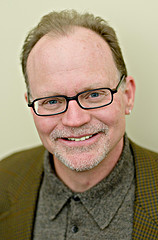Foreign Correspondent: Colvin Reports on Education in Singapore
A system in flux contemplates America's with mixed
emotions
When Richard Colvin visited Singapore in September, he went at the invitation of the U.S. Embassy there as a visiting expert, sharing his expertise on education journalism with members of the media and other local audiences. But Colvin, director of TC's Hechinger Institute on Education and the Media, came home with at least as much new information as he imparted -- much of it of a great interest to educators here.
"The biggest difference between our two education systems is that they really do have a system, very centralized, that's run the Ministry of Education," said Colvin, a former education reporter with the Los Angeles Times, in an interview with Inside (to view a video of the entire interview, click the link to the right of this article). "Most of the decisions that run the system are decided within the Ministry," including the determination of what is, in essence, a national curriculum. "There's not much room for dissent."
Singaporean education is also "built entirely on a foundation of tests and test scores," Colvin reports, though that's now changing, with students taking key placement exams at the primary school, secondary school and post-graduate levels."
It's a system that has worked extremely well for the tiny former British colony. In 2003, Singapore ranked first in both mathematics and science in a 49-country study of Grade 4 and Grade 8 students conducted by the International Association for Evaluation of Educational Achievement. Yet now Singapore is trying to move its education system in a different direction, Colvin says.
"They see their real shortcoming as an over-emphasis on content, content, content. They admire what they see in the U.S. as our greater ability to inspire creativity, open thinking, applying knowledge in novel ways and situations." Hence Singapore's new pedagogical strategy, officially titled "Teach Less, Learn More."
"It's an attempt to adopt a more progressive approach to education," Colvin says. "What we're going through now [in the U.S.] is more testing of the sort that Singapore is trying to move away from."
Still, change isn't occurring without resistance. Many teachers are clinging to old ways, Colvin says, because "they feel under great pressure to make sure kids do well on these exams, because so much is at stake. So there, as here, it's hard to get people to leave the kind of teaching they know."
And there's plenty of skepticism about other aspects of U.S.-style education
"When I talked to them about the high remediation rates we have in our community colleges, they almost didn't have the language to understand," Colvin says. "Their expectation was that if you go to college, you've met the requirements, you've passed the tests, you've jumped through the hoops, and you deserve to be there. They couldn't understand the idea that somebody would go to college and not be able to do college-level work. They couldn't understand the concept of dropouts -- why would anyone turn their back on the educational opportunity being offered to them that would allow them to do well in a job. Our way of training teachers, in a way that's not aligned with what we expect them to teach, is baffling to them. And the final thing they really couldn't get their heads around, and it came up in a lot of my meetings -- they'd ask, Well, aren't the schools in the U.S. meant to serve a national purpose? Isn't the federal government able to summon the schools to serve national goals? And I tried to explain them, essentially, the nature of federalism -- that these decisions are made in the U.S. at a very local level. That the federal government's lever, even with NCLB, is very, very weak to get things to happen in individual schools. And they were perplexed by that because they didn't understand how a great nation could not have a school system that serves its national needs and values."
He took a week long trip to Singapore and talked with education officials, ministers, teachers, principals and higher education leaders. He also provided education coverage training to members of Singapore's print and broadcast media.
There are 580,000 K-12 students, 30,000 more in institutions of technology, and 45,000 in higher education institutions. They would say theirs is very much a meritocracy.
Published Wednesday, Oct. 3, 2007
